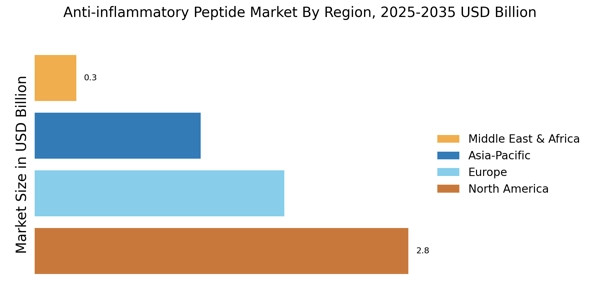Growing Demand for Functional Foods
The increasing demand for functional foods is another significant driver of the Anti-inflammatory Peptide Market. Consumers are increasingly looking for food products that offer health benefits beyond basic nutrition, particularly those that can help manage inflammation. This trend is evident in the rising popularity of foods enriched with anti-inflammatory peptides, such as dairy products, plant-based proteins, and fortified snacks. Market Research Future indicates that the functional foods sector is expected to grow substantially, with anti-inflammatory ingredients becoming a focal point for product development. As manufacturers innovate to meet consumer preferences, the integration of anti-inflammatory peptides into everyday foods is likely to become more prevalent, further driving market growth.
Increasing Prevalence of Chronic Diseases
The rising incidence of chronic diseases such as arthritis, cardiovascular disorders, and diabetes appears to be a primary driver for the Anti-inflammatory Peptide Market. As these conditions often involve inflammation, there is a growing demand for effective anti-inflammatory solutions. According to recent estimates, chronic diseases account for approximately 70% of all deaths worldwide, highlighting the urgent need for innovative treatments. This trend is likely to propel the development and commercialization of anti-inflammatory peptides, as healthcare providers and patients seek alternatives to traditional pharmaceuticals. The increasing focus on preventive healthcare further emphasizes the importance of addressing inflammation at its source, thereby creating a robust market for anti-inflammatory peptides.
Regulatory Support for Natural Health Products
Regulatory support for natural health products is emerging as a key driver for the Anti-inflammatory Peptide Market. Governments and health organizations are increasingly recognizing the benefits of natural ingredients in promoting health and preventing disease. This regulatory backing is likely to facilitate the approval and commercialization of anti-inflammatory peptides derived from natural sources. As a result, manufacturers may find it easier to bring their products to market, thereby expanding the availability of anti-inflammatory solutions. Additionally, favorable regulations may encourage research and development in this field, leading to the discovery of new peptides with anti-inflammatory properties. This supportive environment is expected to enhance market dynamics and stimulate growth.
Technological Advancements in Peptide Synthesis
Technological advancements in peptide synthesis are playing a crucial role in the growth of the Anti-inflammatory Peptide Market. Innovations in biotechnology and synthetic biology have led to more efficient and cost-effective methods for producing peptides. These advancements not only enhance the yield and purity of anti-inflammatory peptides but also enable the exploration of novel peptide sequences with enhanced therapeutic properties. As a result, the market is witnessing an influx of new products that can effectively target inflammation. Furthermore, the ability to customize peptides for specific applications is likely to attract investment and research in this area, fostering a competitive landscape that benefits consumers.
Rising Consumer Awareness of Health and Wellness
Consumer awareness regarding health and wellness is on the rise, which significantly influences the Anti-inflammatory Peptide Market. Individuals are increasingly seeking products that promote overall well-being and reduce inflammation naturally. This shift in consumer behavior is reflected in the growing demand for dietary supplements and functional foods containing anti-inflammatory peptides. Market data suggests that the dietary supplements segment is projected to grow at a compound annual growth rate of over 8% in the coming years. As consumers become more educated about the benefits of anti-inflammatory peptides, manufacturers are likely to respond by developing innovative products that cater to this demand, thereby expanding the market.


















Leave a Comment